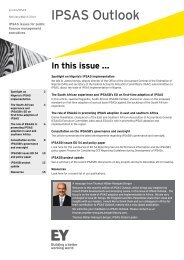Publishing
UC6G3
UC6G3
You also want an ePaper? Increase the reach of your titles
YUMPU automatically turns print PDFs into web optimized ePapers that Google loves.
Since Health Catalyst introduced mobile devices, costs,<br />
which had been rising by approximately 20 percent per year,<br />
are now trending toward annual reductions.<br />
To help its healthcare clients keep pace with the shift, the<br />
company offers training in operational and clinical best<br />
practices along with advanced analytics to track progress.<br />
Health Catalyst’s customer success, as evidenced by the<br />
analytics, is one of its KPIs. In fact, the bonus system is<br />
based on those customer results.<br />
“We try to eat our own dog food,” says Dan Burton, the<br />
company’s CEO, who joined the company in its very early<br />
stages. “We look at our own financial and operational performance<br />
as well as that of our customers to evaluate our<br />
strategy and make decisions.”<br />
Shaving Costs through the Cloud<br />
Susan Hunt Stevens, founder and CEO of WeSpire in<br />
Boston, quips that her company of more than 30 people<br />
and 100 percent annual growth has an extremely low<br />
amount of fixed assets on its balance sheet—only furniture<br />
and a few laptops. Like many entrepreneurial organizations,<br />
WeSpire is using the cloud to dramatically reduce its<br />
technology investments and costs. The company offers a<br />
cloud-based employee engagement platform that organizations<br />
use to drive support for corporate social responsibility<br />
and human resource and sustainability programs. The<br />
platform is offered entirely in the cloud, and the company<br />
uses cloud-based phone, CRM and accounting systems as<br />
well as cloud-based design software. Moreover, WeSpire<br />
capitalizes on the BYOD trend—although it offers to purchase<br />
laptops for employees, it has found most prefer to<br />
use their own to avoid having two computers.<br />
The cloud can also offer affordable global expansion. Mike<br />
Sands, CEO of Signal, headquartered in Chicago, offers a<br />
platform that helps companies provide seamless experiences<br />
for customers despite the complexity of recognizing<br />
them as they move across multiple channels and touch<br />
points. The platform is entirely cloud based, which makes<br />
it easier for Signal to expand into overseas markets. “You<br />
can now focus on the idea and the people who make ideas<br />
possible versus who will pay for the next server to rack and<br />
stack data in some faraway country,” says Sands. “It’s all<br />
virtual now and a true golden age of entrepreneurship.”<br />
Becoming Mobile<br />
Mobile is also changing how these entrepreneurial businesses<br />
work. Cloud Sherpas, for example, is working with<br />
its clients to implement mobile applications that put data<br />
quickly into the hands of employees. And it is using the<br />
applications in its own operations. “Our view is that we<br />
need to bring the power of analytics to employees, “says<br />
Northington. “We are driving the movement of analytics<br />
from IT to individuals on their mobile devices.”<br />
Mobile and wearable devices can cut healthcare costs.<br />
Using applications such as Fitbit, Health Catalyst employees<br />
can track lifestyle improvements and also compete<br />
with other employees. Health Catalyst offers discounts<br />
on health insurance when their employees meet certain<br />
milestones and self-funds its employee health insurance.<br />
Since it introduced mobile devices, costs, which had been<br />
rising by approximately 20 percent per year, are now trending<br />
toward annual reductions.<br />
A DELICATE BALANCE<br />
To grow, and often to expand their outreach and distribution,<br />
entrepreneurial companies sometimes need to<br />
partner with organizations that are much larger than<br />
themselves. The challenge then becomes balancing the<br />
needs of these larger companies with the best interests<br />
of the smaller partner. The high-growth entrepreneurial<br />
organizations in this study have found a productive<br />
equilibrium by forging strategic relationships in which<br />
each party brings something valuable to the table and<br />
interests between the two are mutually aligned. SGN is<br />
a case in point.<br />
HARVARD BUSINESS REVIEW ANALYTIC SERVICES 5





